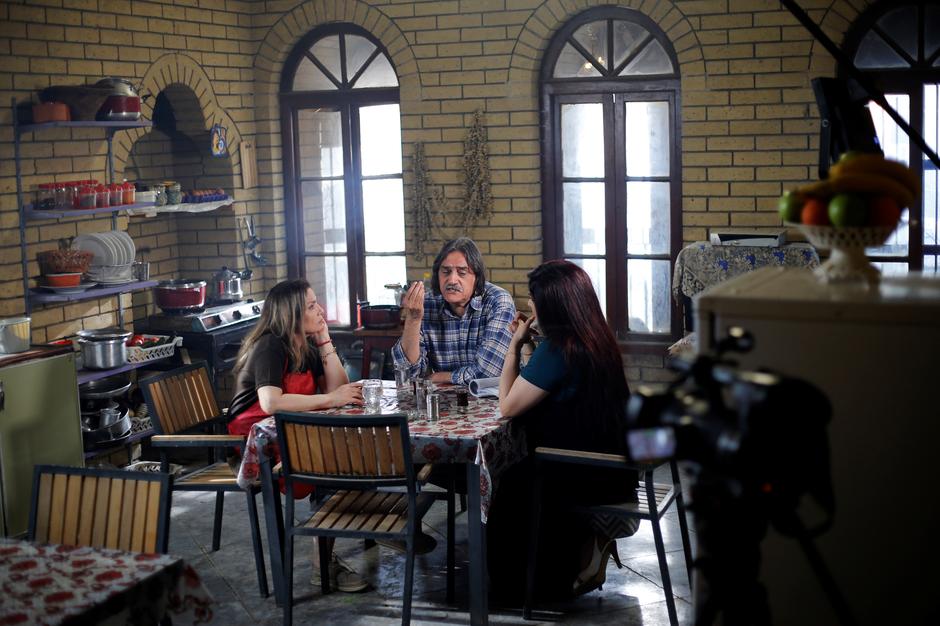The representation of the life story of al-Hassan and al-Hussein, Prophet Mohamed’s grandsons and sons of his cousin and son-in-law, Ali Ibn Abi Taleb, in a daily TV series during Ramadan has been a topic of dispute. Being the descendants of Ali, whom Shia believe should be the successor of the Prophet, Hassan and Hussein are figures of the Shia denomination, which split off in the early years of Islam.
The showing of the series was met with staunch and traditional criticism from Al-Azhar, the Muslim world’s prestigious Sunni institution, mainly on the question of the personification of the Prophet's companions and family members. Meanwhile, it was encouraged by a group of intellectuals, jurisprudents and enlightened religious scholars who are generally described as modernists.
However, the divergence over the personification in the series was a disappointment as it sidelined an important conversation on the rather poor artistic value of the work. The divergence was equally deceptive because proponents of the series eventually embraced a rather traditional and orthodox Sunni narrative in essence, which reflected an ideological choice, while their modernist stance was reduced to a gesture.
The series recounts the events of the people living in the early territories of Islam, the rebellion against the third Righly Guided Caliph Uthman Ibn Affan (AD 575-656), one of the prophet’s companions, and his subsequent assassination. Uthman’s death is followed by the Battle of the Camel (656), where Aisha Bint Abi Bakr, one of the prophet’s wives, Talha Ibn Obaidallah and al-Zubair Ibn al-'Awwam, companion and cousin of Mohamed respectively, opposed the rule of the fourth caliph, Ali (599-661), which ends with the death of the latter and Muawiya Ibn Abi Sufian (602-680) taking over the caliphate.
Those 10 years of civil war in the early Muslim world constituted the foundation of major Islamic political and doctrinal divergences, which called on the interest of historians and scholars.
The screenwriters, however, disregard much of the contentious historic accounts presented in works by scholars such as Abu Jaafar al-Tabary and Ibn Jaber al-Balazery among others. Those accounts showcase visible contradictions in dates, names, roles and sequence of events. The series, however, opted for a single plane historic narrative, one that is considered the classic and official account embraced by many over centuries. This stance reveals an ideological position par excellence, one that can only be understood in the context of a prevalent desire to preserve the determinants of Arab political thought with regards to the questions of the caliphs’ succession and more broadly political opposition and legitimacy of rule in addition to the uncontested authority of the Prophet's companions in transmitting Quranic interpretations and prophetic hadith (collected statements and deeds of the prophet).
According to this classic narrative, a Jewish man from Yemen called Abdullah Ibn Sabaa, commonly known as Ibn al-Sawdaa is behind the civil war, historically known as the Great Fitna (religious strife).
Ibn al-Sawdaa converted to Islam with the sole purpose of dividing it from the inside in order to quell his hatred to Muslims as a Jewish man. Historians disagree over the very existence of this man, his name, hometown and deeds, while some go as far as saying that Ibn al-Sawdaa is no one but Ammar Ibn Yasser, one of the prophet’s companions.
The issue at stake is not really the identity of Ibn al-Sawdaa, but rather the comfort at demonizing him as a man with a mobility that takes him from Yemen, to Mecca, Medina, Basra, and to the Levant, armed with some invincible magic powers that beat tribes’ leaders, fighters, the prophet’s companions, Arabs and non-Arabs equally. He is allegedly a malign and dangerous man who managed to influence powerful figures such as Abi Bakr, Talha, Zubair and Ali. He is also allegedly the man who incited early Muslims against Uthman, and enticed them to kill him; he called on Abi Bakr, Talha, Aisha to go to Basra, which led to the Battle of the Camel; and he spurred the strife that rocked Siffin in fighting between Ali and Muawiya. He is held to be a knowledgeable man of the matters of Jews, Christians, Persians and Indians, with an unmatched slyness.
Islamic Sunni thought has comfortably espoused this rather extraordinary interpretation as a means to escape a historic impasse concerning the fact that Mohamed’s companions, the preachers of Islam and the favorites of the Prophet have fought amongst themselves, killing four in the process: Uthman was killed by early Muslims in the Prophet’s city, Talha and Zubair were killed in the battlefield against Ali, and Ali was killed by Ibn Muljam al-Khareji, who rejected his leadership.
The justice of the Prophet’s companions is a crucial question because it institutes for the hadith and its interpretation. The principles of jurisprudence have been built on the assumption of the justice and honesty of players in the Great Fitna like Ali, Muawiya, Uthman, Talha, Zubair, Aisha and Amr Ibn al-As, who brought Islam to Egypt. With the exception of Abbas al-Akkad’s attempts in his “Geniuses,” the psychological unpacking of these characters is not present in Islamic thought.
Where is the series from that? The series presented a classical narrative, highly literal in nature. Early Muslims rebelled against Uthman, but had no real motivations for this rebellion in terms of a mediocre ruling or corrupt policies. It was rather the devil’s work, given the obsession of Ibn al-Sawdaa.
The representation of the Prophet’s companions and other main players in the conflict is highly superficial, lame and almost mechanical, as it misses out on human complexity. Marwan Ibn al-Hakam is presented as an idealistic, angelic man with no mistakes. None of the Prophet’s companions did any wrong in the battles of the Camel and Siffin. Talha, Zubair and Muawiya did not seek power, nor did they withdraw their support to Ali. They only went out to seek revenge for Uthman’s death because of the obsession of Ibn al-Sawdaa.
Otherwise, they would have made peace. This narrative fortifies the fact that opposing the ruler, or the patriarch, and disobeying him are no more than the work of the devil.
The series – a Qatari, Syrian, Kuwaiti, Moroccan and Jordanian co-production – crystallized an audience divided into modernists who celebrate the superficially progressive achievement manifested in the personification of Hassan and Hussein on screen, which for long has been held as taboo, and Salafis angered by this process, but at least satisfied with the reproduction of a narrative that traces the Shia denomination to the malign Jewish Ibn al-Sawdaa. This mode of thinking represents the crux of a consumerist brand of Salafism, which puts on a modernist attire and is marketed for by some players in the Arab world today.
An Arabic version of this review appeared in the weekly literary journal Akhbar al-Adab.




